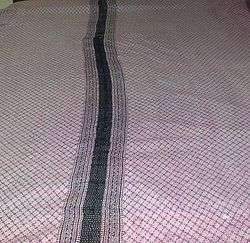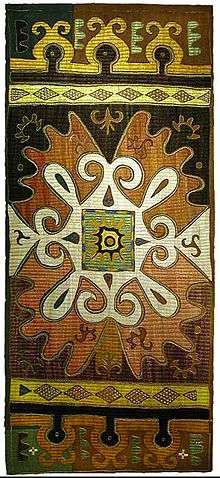Kantha
Kantha is a type of embroidery in eastern South Asia, especially Bangladesh and parts of West Bengal and Odisha. In Odisha old saris are stacked on each other and hand-stitched to make a thin piece of cushion. This is normally used above a bed cushion or instead of a cushion.[1] "Kantha saris" are traditionally worn by women in Bengal.[2]
Kantha stitching is also used to make simple quilts, commonly known as Nakshi Kantha. Women in Bengal typically use old saris and cloth and layer them with kantha stitch to make a light blanket, throw or bedspread, especially for children. Kantha is very popular with tourists visiting Bengal and is a specialty of Bolpur, West Bengal, India
Weave

Kantha is a form of embroidery often practised by rural women. The traditional form of Kantha embroidery was done with soft dhotis and saris, with a simple running stitch along the edges. Depending on the use of the finished product they were known as Lepkantha or Sujni Kantha.
The embroidered cloth has many uses including women's shawls and covers for mirrors, boxes, and pillows. In the best examples, the entire cloth is covered with running stitches, employing beautiful motifs of flowers, animals birds and geometrical shapes, as well as themes from everyday activities. The stitching on the cloth gives it a slight wrinkled, wavy effect. Contemporary Kantha is applied to a wider range of garments such as sarees, dupatta, shirts for men and women, bedding and other furnishing fabrics, mostly using cotton and silk. Modern Katha-stitch craft industry involves a very complex multi-staged production model.[3]


Other uses of the word
Kantha also means "throat". The name Nilakanth is given to Lord Shiva, literally meaning "blue throat" after he swallowed the poison that resulted from the churning of the ocean, or "Throat chakra". Kantha is also used as an adjective to describe a style of necklace that lies close to the throat, open at the back.
See also
Bibliography
- The Art of Kantha embroidery, by Niaz Zaman. University Press, 1993. ISBN 984-05-1228-5.
- Jasleen Dhamija (2004). Asian embroidery. Abhinav Publications. ISBN 81-7017-450-3.
- Kantha: the embroidered quilts of Bengal, by Darielle Mason, Pika Ghosh, Katherine Hacker, Anne Peranteau. Yale University Press, 2010. ISBN 0300154429.
References
- ↑ India. Office of the Registrar General. Census of India, 1961: Orissa. Manager of Publications.
- ↑ http://www.thehindu.com/arts/history-and-culture/article2090455.ece
- ↑ Roy, Paramita and Sattwick Dey Biswas (2011). Opportunities and Constraints of the Kantha-stitch craftswomen in Santiniketan: a value chain analysis. Journal of Social Work and Social Development (ISSN 2229-6468). pp. 5-9.


